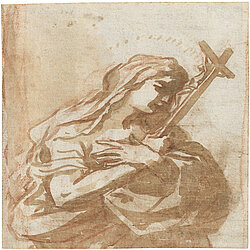Loading the page ...
Elisabetta Sirani
1638–1665, Bologna
Around the middle of the 17th century Elisabetta Sirani was indisputably one of the most respected young artists in Italy and her style of painting with its distinct Baroque pathos proved highly influential. This “pittrice eroina”, as her first biographer Carlo Cesare Malvasia (1616–1693) called her in his collection of biographies Felsina Pittrice published in 1678, began her career in the studio run by her father, the painter Giovanni Andrea Sirani. He had been one of Guido Reni’s closest associates up to 1642 and set up his own studio after Reni’s death in which he gave painting lessons, amongst others, to three of his daughters. Elisabetta profited from the elite circle of aristocratic and scholarly clients with whom her father dealt, successfully completing her first commissions at the tender age of seventeen. In the decade that followed she became one of the most sought-after artists in Bologna, numbering Cosimo III de’ Medici, the later Grand Duke of Tuscany, among her patrons. In 1662 she took charge of her father’s studio and for a number of years trained students of painting herself before a sudden illness – and not, as originally suspected, poison – ended her life in 1665 when she was a mere 27 years of age.
Archive
